Aigeai in Cilicia and Tyre in
Phoenicia. A Surprising Connection*
Abstract:
In this paper three mid-3rd century AD coin types of
the civic coinage of Aigeai in Cilicia are discussed, and it is
suggested that they were modeled on prototypes from Tyre in
Phoenicia. The images on all three coin types are firmly rooted
in Tyre and were adopted by Aigeai. This observation has
consequences for the interpretation of the Aigeaian coins and
calls for caution when trying to understand such coin images
only from the local context of the minting authorities.
Keywords:
Tyros (http://nomisma.org/id/tyre),
Aigeai (http://nomisma.org/id/aegeae_cilicia),
Roman provincial coinage
(http://nomisma.org/id/roman_provincial_numismatics),
Kadmos (https://d-nb.info/gnd/118930222), Heracles
(https://d-nb.info/gnd/118639552),
Apollon (https://d-nb.info/gnd/118503642),
Thea Roma
Zusammenfassung:
In diesem Beitrag werden drei Münztypen der städtischen
Münzprägung von Aigeai in Kilikien aus der Mitte des 3.
Jahrhunderts n. Chr. besprochen, und es wird herausgearbeitet,
dass sie nach Vorbildern aus Tyros in Phönizien gestaltet sind.
Alle drei Bilder sind ursprünglich fest in Tyros verwurzelt und
wurden erst sekundär in Aigeai übernommen. Diese Beobachtung hat
Konsequenzen für die Interpretation der aigeaischen Münzen und
erfordert Vorsicht, wenn man versucht, solche Münzbilder nur aus
dem lokalen Kontext der Prägeautoritäten zu verstehen.
Schlagwörter:
Tyros, Aigeai, kaiserzeitliche Städteprägung, Kadmos, Herakles,
Apollon, Thea Roma
Aigeai in Cilicia and
Tyre in Phoenicia are two important harbor cities in the eastern
Mediterranean with a prolific production of civic bronze coins
in the Roman imperial period, especially in the 3rd
century AD[1].
Both cities boasted their civic traditions and cults: Aigeai was
proud of her cult of Asclepios and depicted the eponymous goat
on her coinage, Tyre represented the time-honored cult of
Heracles-Melqart and referenced foundation stories of Dido and
Kadmos. Both cities stressed their link to the Mediterranean
Sea, featuring ships and maritime themes. In the following,
three remarkable adoptions of motifs are discussed which suggest
a special connection between the two cities in the 250s AD.
Kadmos and a foundation hero
Tyre elaborates on its
relation to the civilizing hero Kadmos[2].
Among other mythical scenes, which include his sister Europa,
the city since the time of Philippus Arabs (r. 244–249 AD)
minted a coin type showing Kadmos standing to the left in front
of a bull. He holds a spear in the crook of his left arm and a
patera in his outstretched right hand (fig. 1)[3].
In the upper left part of the scene is a vignette of a city with
gate and towers. The same type was also minted in Tyre under the
emperors Trebonianus Gallus[4]
and Volusianus[5]
(r. 251–253 AD). Again in the reign of emperors Gallienus[6]
(r. 253–268 AD), Valerianus (r. 253–269)[7]
and Salonina[8],
this coin type was produced, and it is in this period that the
vignette of the city is identified through the Greek legend ΘΗΒΕ
as Thebes (fig. 2). The legend unambiguously clarifies
that the coin depicts the well-known myth of Kadmos, a hero from
Tyre, who was guided by a bull to the place in Boiotia where he
first fought a dragon – a topic which is also featured on Tyrian
coins[9]
– and later founded Thebes. This image lays claim to the Greek
civilizing hero and connects him to his Phoenician hometown
Tyre. Kadmos is a key figure in the coinage of Tyre, other types
show him embarking on a ship[10],
standing with his wife Harmonia[11]
and handing over the script to Greeks[12].
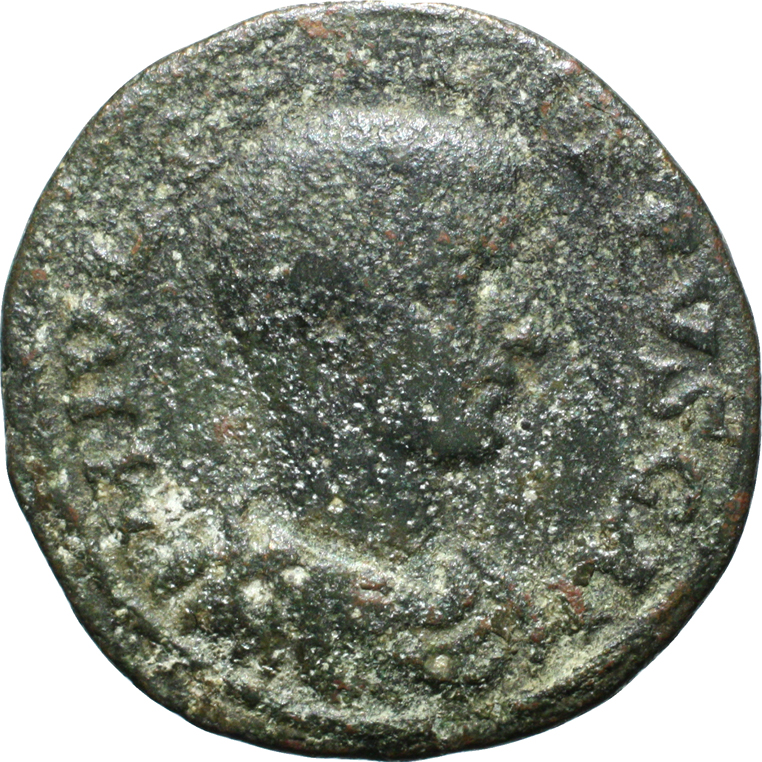
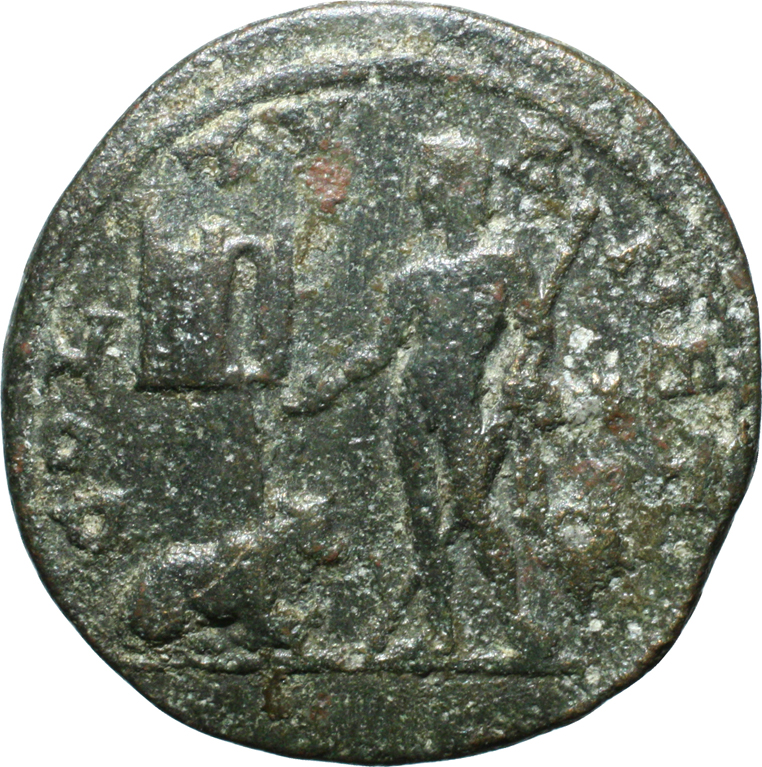
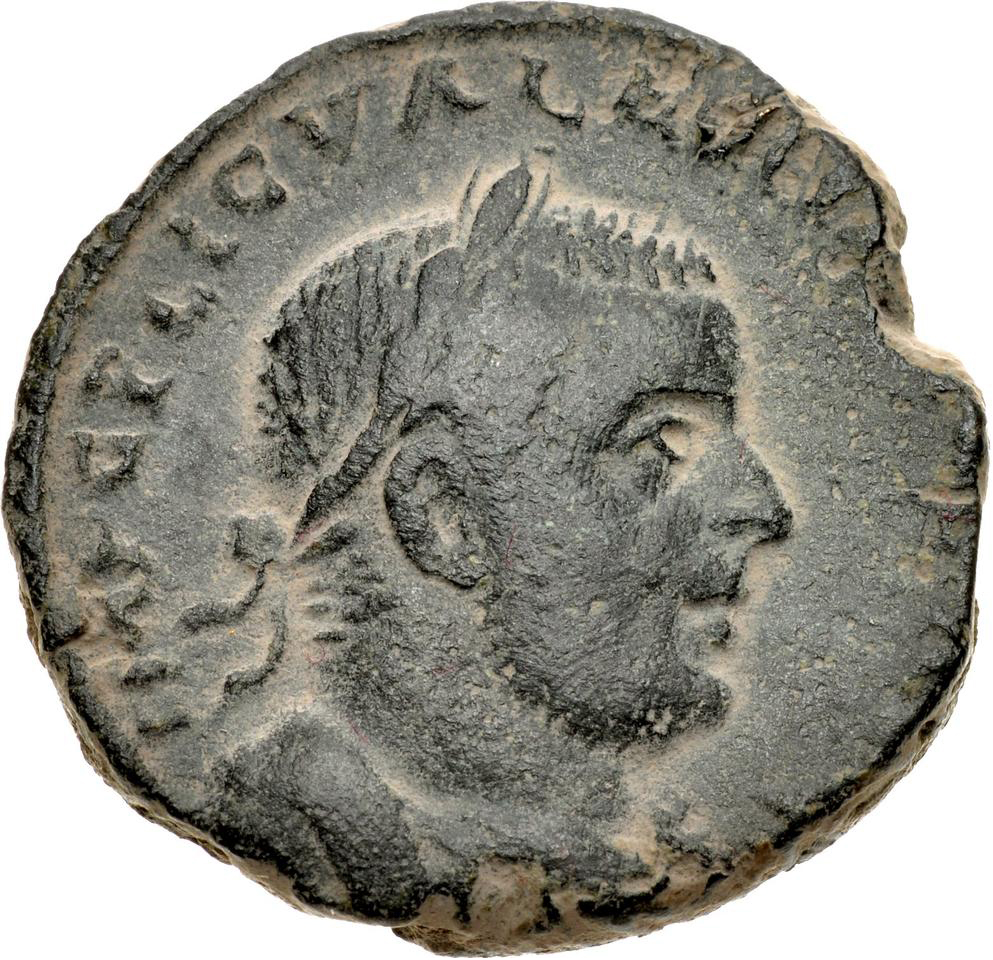


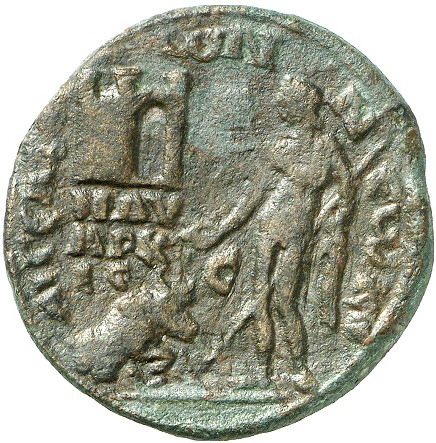
Under the emperor
Aemilianus (r. 253 AD), Aigeai minted a coin type which on the
reverse depicted exactly the same scene of a standing man with a
spear in the crook of his arm and patera as well as the bull and
the vignette of a city (fig. 3)[13].
The legend under the vignette reads NAYAPXIC and thus relates to
Aigeai ruling the waves.
Even if the motive of a
bull leading the city founder to the place of a foundation is a
frequent motif in Greek foundation myths[14],
it is obvious that the coin types of Aigeai and Tyre are
formally so closely related that one served as the model for the
other[15].
Since the type is first attested in Tyre, it has to be assumed
that this was the model for the coin type of Aigeai[16].
This is also supported by the observation that the theme fits
nicely with the broadly communicated message of the Tyrian coin
emissions dealing with Kadmos as founder of Thebes. The attempt
to find a connection between Aigeai and Kadmos, as presented by
Tanja Scheer, is very much artificially constructed and not very
compelling[17].
Florian Haymann has convincingly suggested that in Aigeai a
local foundation hero was depicted, whose name we cannot
identify with certainty[18].
Since this topic is not further elaborated in the coinage of
Aigeai, it seems indeed that a Tyrian coin type was adopted in
Aigeai. This adoption related to a coin type that was specific
to Tyre and the adoption for an otherwise unattested founder was
later applied in Aigeai and could have been related to an
otherwise unknown founder of the city.
Heracles and Apollon
Under the emperors
Trebonianus Gallus (r. 251–253 AD)[19]
and Gallienus[20],
Tyre minted a coin type depicting on the reverse a standing
Heracles and an Apollon embracing, both holding their
attributes, club and lyra (fig. 4). They each stand in a
pronounced contrapposto pose resulting in a rhombus shaped
composition of the couple. Heracles is the main deity of Tyre,
and Apollon is also a traditional god of the city, even though
he makes no further appearance on the city coins. In Tyre, this
type was accompanied by several agonistic coins referencing the
local Heracleia and Actia and I have argued elsewhere that the
Heracles and Apollon type specifically relates to these Tyrian
civic games[21].
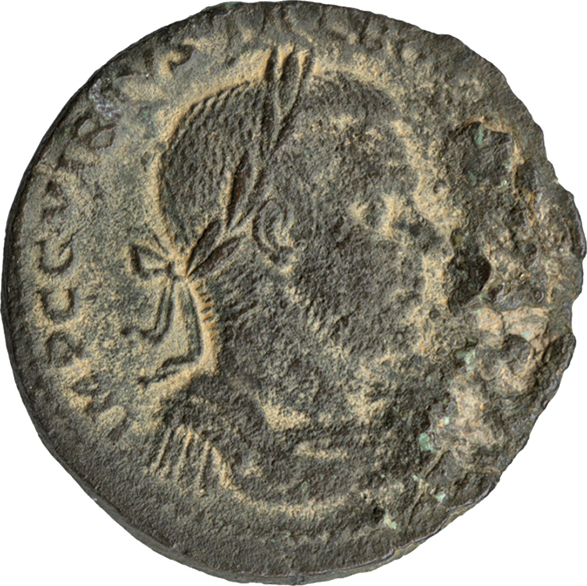


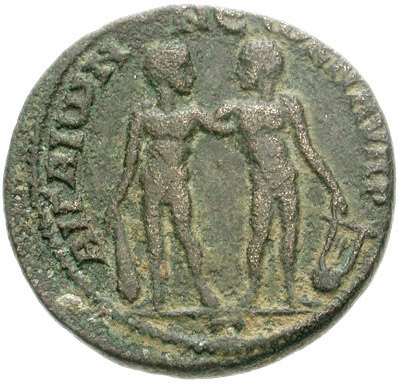
In the time of
Gallienus, Aigeai also minted a coin type depicting Heracles and
Apollon on the reverse (fig. 5)[22].
Because it is formally and stylistically very similar it has to
be assumed that the two images are related. Again, it is likely
that the earlier coin type of Tyre served as the model for the
coin type of Aigeai. Similar representations of the two deities
as a couple are extremely rare[23].
The idea that the Tyrian coins inspired the one from Aigeai is
supported by Haymann’s observation that within the minting
history of the city, it is an exceptional depiction in Aigeai
which he explains by suggesting that Apollon was possibly
venerated in Aigeai as a founder, even if there is no evidence
for this. There is however a Hellenistic bronze coin of the city
with Heracles on the obverse and a tripod on the reverse that
could attest to some traditional connection between the two
deities in Aigeai[24]
which might have inspired the adoption of the image of the
embracing deities. Again, as with the Kadmos type, we have a
unique coin image in Aigeai, which compares closely with a
Tyrian coin image. In Tyre it can be explained by the local
myths and the civic games related to the two deities. In Aigeai
an explanation for their representation is not as
straightforward but it seems plausible that some meaning could
be ascribed to the image also within a civic context.
Thea Roma
Under Trebonianus Gallus[25] and Volusianus[26], Tyre minted civic coins depicting the enthroned Thea Roma on the reverse (fig. 6). She is seated facing left and holds two small figures in a galley in her right hand and a spear in her left arm. The two figures in a galley in her hand probably relate to some maritime myth of Tyre[27]. A shield is placed in front of Thea Roma. Other programmatic coin types were minted at the same time, namely one featuring Thea Roma and the Tyche of Tyre as a couple[28], with images of a handshake[29] underlining the concord between Rome and the city of Tyre. Parallel to Thea Roma, coins depicting Tyche were also produced in Tyre[30], suggesting that a full program of Tyche, Thea Roma, Tyche and Thea Roma as well as the symbolic handshake promoted the intimate bond between Tyre and Rome. The Thea Roma type is continued under Valerianus[31] and Gallienus[32]; under Gallienus Thea Roma is even depicted in a hexastyle temple[33].
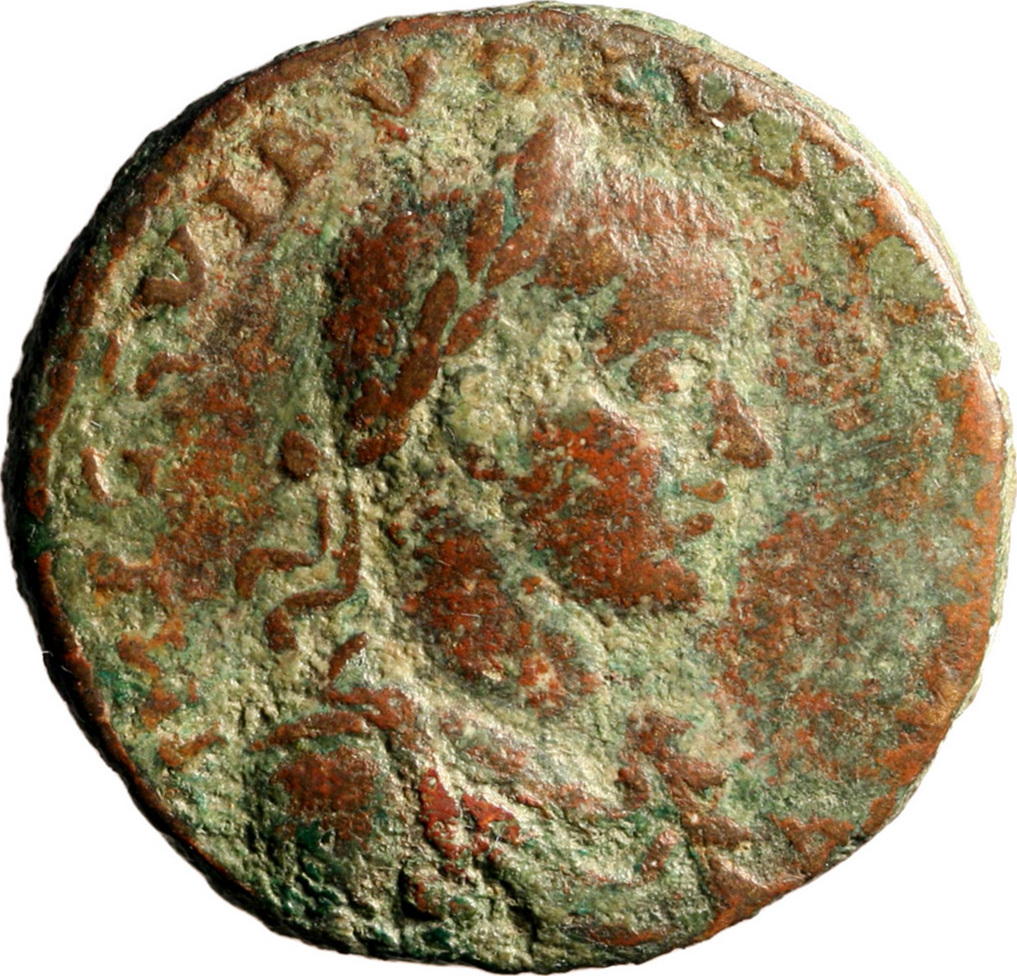
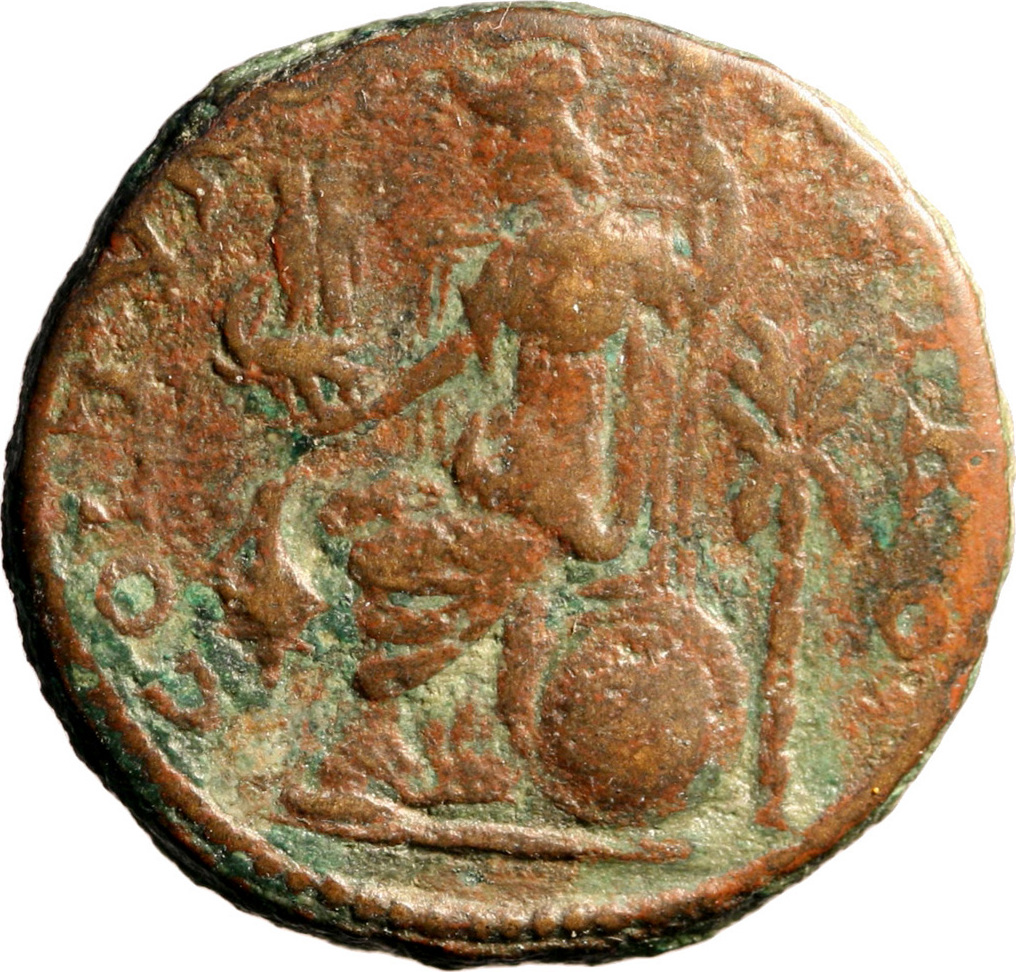


A short time later,
under Valerianus, Aigeai depicted the same seated Thea Roma on
the obverse of a bronze coin, but this time she does not hold
the two figures in a galley in her right hand but a Nike (fig. 7)[34].
The seated female figure had been identified as Athena by
Florian Haymann because of her importance in the city, but the
commonalities with the Tyrian coin image are apparent and a
seated Athena is lacking in previous coins of Aigeai so that
again it can be assumed that the isolated coin of Aigeai is
modelled on the Thea Roma coin type of Tyre. Even if in this
case it has to be stressed that a seated Thea Roma type is quite
common in the eastern Mediterranean[35]
and the possible connection between Tyre and Aigeai is less
certain than that postulated with the other two types discussed
above. If, however, the Tyrian coin type inspired the coin of
Aigeai, then it can be considered, as Haymann assumed, that it
was indeed adopted as a type for the local Athena and not
necessarily related to Thea Roma because at that time Rome as a
topic is not as dominant in Aigeai as in Tyre and Thea Roma
could be locally rebranded as Athena.
Aigeai and Tyre
The adoption of coin
motifs from Tyre in Aigeai is surprising, since there is no
evidence for a special relationship between Aigeai and Tyre in
the 250s AD. The strongest connection that can be seen between
the two cities is their importance as stops on maritime routes
in the eastern Mediterranean. Aigeai had a special position as a
stepping stone to Syria and Alexandria[36],
and Haymann showed that its civic coinage in the mid-3rd
century AD was also influenced by coin images from Northern
Syrian cities[37].
The new evidence for the adoption of coin images from Tyre
underlines that Aigeai in this period has to be seen as a
melting pot and that also cities along the southern Levantine
coast such as Tyre influenced the choice of coin motifs in
Aigeai.
What are the practical
consequences of such an adoption? There is no evidence that the
adoption resulted from a sharing of dies, as has been observed
for other cities in Asia Minor[38].
Such die links are usually more regional (»Lieferbezirke«) and
not trans-Mediterranean. Also, in Aigeai the obverse die links
of this period are restricted to Cilicia[39].
We therefore have to assume that Tyrian bronze coins indeed
travelled to Aigeai and that at least some of them, which could
be integrated into the civic images, were adopted. These
adoptions were not random but the coin images of Tyre were
chosen because they offered an option for integration into the
visual world of Aigeai. It seems that coin images were adopted
during a period of crisis, when Shapur had occupied Northern
Syria[40]
and Aigeai increased its minting output. It is not possible to
find a more clear and concrete explanation for the surprising
connection between the coinage of Aigeai and Tyre, but it is
useful to describe the phenomenon and, in the future, to look
out for similar adoptions. What we can learn in any case from
the three examples is that sometimes the reverse images on civic
coins of the Roman period were not necessarily originally
designed for their use in the minting city but could be adopted
from foreign contexts. This however does not imply that the
images were arbitrary and lacked local meaning, but they had to
fulfil certain criteria to be adaptable to different contexts,
namely that it must have been possible to ascribe new local
meaning to them. Thus, they shed light on the sometimes
surprisingly non-linear and multi-authored creation of coin
images and they call for caution in interpretation if we do not
entirely understand the complexity of their genesis.
*
Thanks are due to Florian Haymann (Frankfurt) for
commenting on an earlier draft of this paper.
[1] On
the coinage of Aigeai see Haymann 2014. A detailed
analysis of the Roman coinage of Tyre is still a
research desideratum. In recent years several
iconographic studies on the Tyrian coins were published,
most recently by Bijovski 2020 and Palistrant Shaick
2021 with further bibliography.
[2] Hirt
2015.
[6] Babelon
1893, 346 no. 2341; Rouvier 1904, 103 no. 2532; BMC
Phoenicia 293 no. 487.
[7] Rouvier
1904, 99 no. 2500.
[8] Babelon
1893, 349 no. 2360; Rouvier 1904, 107 no. 2565; Baramki
1974, 266 no. 311.
[9]
Elagabalus: Babelon 1893, 327 no. 2236; Rouvier 1904, 77
nos. 2372. 2374. Gordian III: Babelon 1893, 333 no.
2266; Rouvier 1904, 86 nos. 2428–2429; BMC Phoenicia 280
f. nos. 425–426. Gallienus: Babelon 1893, 346 nos.
2339–2340 ; Rouvier 1904, 103 nos. 2530–2531. Salonia:
Rouvier 1904, 107 no. 2564; BMC Phoenicia 295 no. 496.
[10] E.g.
BMC Phoenicia 277–294 nos. 411. 446. 469. 489.
[13]
Haymann 2014, 354–355 M230.
[14] Cf. Lichtenberger 2003,
95 n. 743.
[15] See also Haymann 2014,
197.
[16]
Contra
Haymann 2014, 197 (who was not aware that the type is
first attested in Tyre).
[17]
Scheer 1993, 317–320. The figure on the coin type of
Aigeai is also identified by Bloesch 1989, 20 as Kadmos.
[18]
Haymann also correctly questions the identification with
Alexander the Great as suggested in SNG Levante 1788.
[21] Lichtenberger 2023.
[22] Haymann 2014, 360 M254.
[23] Lichtenberger 2023.
[24] Haymann 2014, 173.
[27]
Among the myths depicted in Tyrian coinage Dido and
Kadmos are the most likely seafaring heros which could
have been referenced in the Thea Roma image, even if
also a more general maritime message of the image might
have been intended.
[30] One
of the most common coin types of Tyre, cf. e.g. BMC
Phoenicia 269–292 nos. 369. 372–373. 385. 388–393.
396–405. 416. 419. 423–424.
431–432. 436. 445. 449–453. 474–477.
[31] Babelon
1893, 343 no. 2324; Rouvier 1904, 99 no. 2498; BMC
Phoenicia 287 nos. 454–454. 456–457.
[32] Rouvier
1904, 103 nos. 2527–2528; BMC Phoenicia 292 no. 480;
Baramki 1974, 264 nos. 296–297; Gemini, LLC Auction VI,
10. January 2010,
lot 786.
[33]
Baramki 1974, 266 no. 308. This
parallels similar depictions of Tyche in a hexastyle
temple.
[34] Haymann 2014, 358 M245.
[35] Vermeule 1959.
[36] Robert 1973, 170–171;
Holtheide 1982, 9; Haymann 2014, 7–9. 279 no. 37.
[37] Haymann 2014, 129–138.
[38] Kraft 1972; Watson
2019.
[39] Kraft 1972, 87.
[40] Kettenhofen 1982.